Geography Playlist
19 chapters • 0 completed
The Universe and the Earth
18 topics
Atmosphere and its composition
6 topics
Atmospheric Temperature
11 topics
Atmospheric Moisture
9 topics
Air Mass, Fronts & Cyclones
15 topics
Evolution of Earths Crust, Earthquakes and Volcanoes
23 topics
Interior of The Earth
14 topics
Landforms
25 topics
Geomorphic Processes
10 topics
Movement of Ocean Water
16 topics
Oceans and its Properties
12 topics
Climate of a Region
14 topics
Indian Geography - introduction, Geology
5 topics
Physiography of India
27 topics
Indian Climate
20 topics
Indian Drainage
32 topics
Soil and Natural Vegetation
13 topics
Mineral and Energy Resources, Industries in India
28 topics
Indian Agriculture
22 topics
Chapter 1: The Universe and the Earth
Chapter TestThe Universe and the Earth
The universe is a vast expanse of space containing all matter and energy in existence. Scientists believe it is expanding outward, and different models have been proposed to explain its structure.
The universe is a vast expanse of space containing all matter and energy in existence. Scientists believe it is expanding outward, and different models have been proposed to explain its structure.
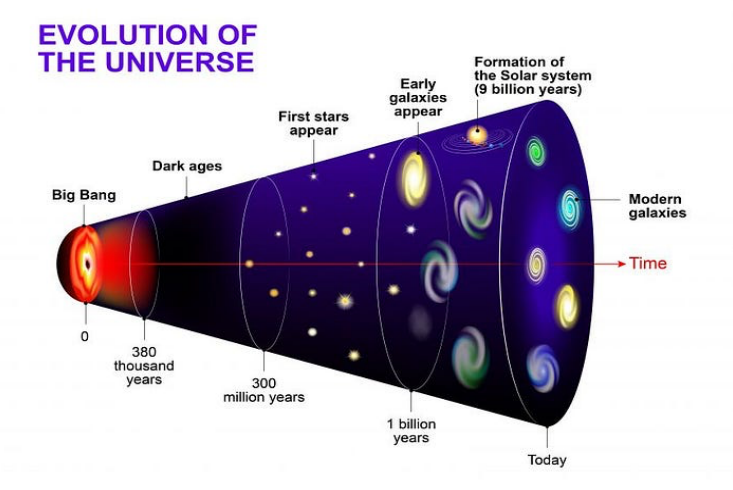
Different Views on the Universe
| View | Description |
|---|---|
| Geocentric | Earth is at the center of the universe. |
| Heliocentric | Sun is at the center; Earth revolves around it (proposed by Aristarchus). |
Mains Key Points
Prelims Strategy Tips
Big Bang Theory
The Big Bang Theory, proposed by George Lemaitre, explains the origin of the universe around 13.8 billion years ago from a singularity (infinite mass, zero volume). It rapidly expanded, forming the present universe. Supporting evidences include red shift of galaxies and cosmic microwave background radiation.
The Big Bang Theory, proposed by George Lemaitre, explains the origin of the universe around 13.8 billion years ago from a singularity (infinite mass, zero volume). It rapidly expanded, forming the present universe. Supporting evidences include red shift of galaxies and cosmic microwave background radiation.
Big Bang Theory – Key Aspects
| Aspect | Details |
|---|---|
| Originator | George Lemaitre |
| Age of Universe | Around 13.8 billion years |
| Starting Point | Singularity (infinite mass, zero volume) |
| Process | Inflation and violent explosion leading to expansion |
| Evidences | Red Shift of galaxies, Cosmic Microwave Background Radiation |
Mains Key Points
Prelims Strategy Tips
Galaxies
Galaxies are vast systems of gas, dust, and billions of stars held together by gravity. They exist in different shapes – spiral, elliptical, and irregular. Our solar system is located in the Milky Way, a spiral galaxy containing a supermassive black hole (Sagittarius A*) at its center.
Galaxies are vast systems of gas, dust, and billions of stars held together by gravity. They exist in different shapes – spiral, elliptical, and irregular. Our solar system is located in the Milky Way, a spiral galaxy containing a supermassive black hole (Sagittarius A*) at its center.
Types of Galaxies
| Type | Features | Example |
|---|---|---|
| Spiral | Disc-shaped with spiral arms; actively forming stars. | Milky Way |
| Elliptical | Circular to elongated; little gas/dust; older stars. | Most abundant in universe |
| Irregular | No defined shape; little dust. | Large Magellanic Cloud |
Milky Way – Key Facts
| Aspect | Details |
|---|---|
| Size | 100,000 light-years across |
| Age | 13.6 billion years |
| Type | Spiral Galaxy |
| Core | Sagittarius A* (supermassive black hole) |
| Structure | Galactic Bulge, Galactic Disc |
| Nearest Galaxy | Andromeda |
Mains Key Points
Prelims Strategy Tips
Stars and Constellations
Stars are giant glowing balls of gas (mostly hydrogen and helium) held by gravity. Their color depends on temperature – blue stars are hottest, red are coolest. Constellations are recognizable patterns of stars, with 88 officially recognized ones, used for naming, navigation, and astronomical references.
Stars are giant glowing balls of gas (mostly hydrogen and helium) held by gravity. Their color depends on temperature – blue stars are hottest, red are coolest. Constellations are recognizable patterns of stars, with 88 officially recognized ones, used for naming, navigation, and astronomical references.
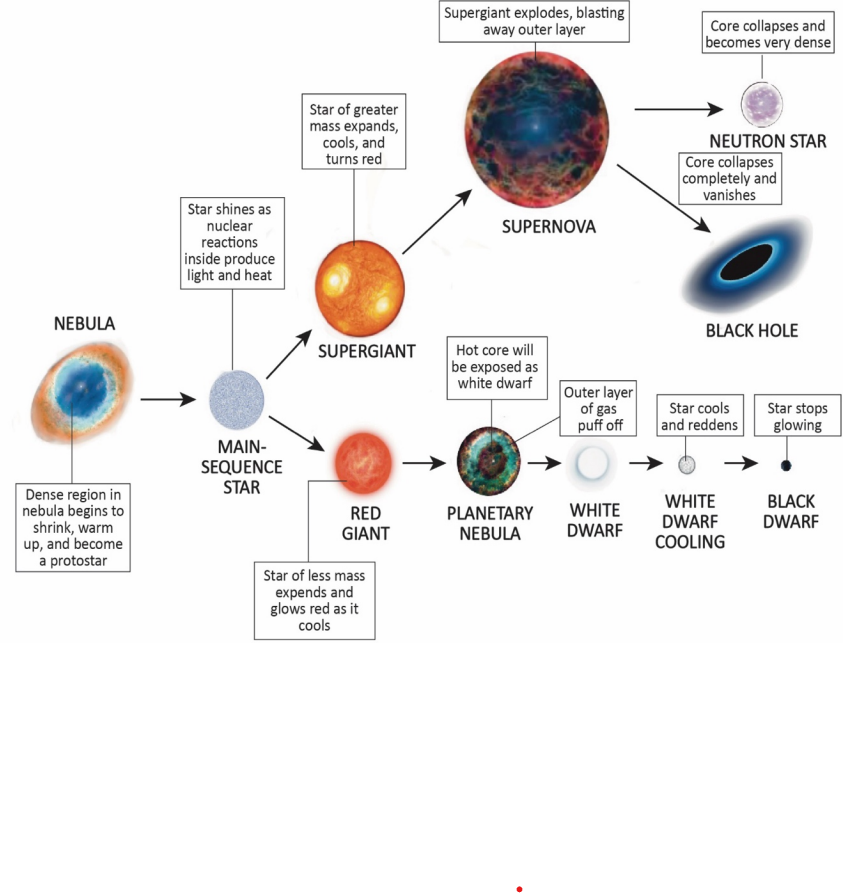
Star Colors and Temperatures
| Color | Temperature Range | Remarks |
|---|---|---|
| Blue | Above 10,000 K | Hottest stars |
| White | 7,500 – 10,000 K | Very hot |
| Yellow | 5,000 – 7,500 K | Medium (e.g., Sun) |
| Red | Below 3,500 K | Coolest stars |
Examples of Constellations
| Constellation | Shape/Association |
|---|---|
| Ursa Major | Great Bear (Saptarishi) |
| Ursa Minor | Little Bear |
| Orion | Hunter |
| Cassiopeia | Mythological Queen |
Mains Key Points
Prelims Strategy Tips
Solar System
The Solar System is a gravitationally bound system of the Sun and the celestial objects that orbit it. The space beyond the solar system is known as interstellar space. Multiple theories explain its origin and evolution, ranging from Kant’s Gaseous Hypothesis to Hoyle’s Supernova Hypothesis.
The Solar System is a gravitationally bound system of the Sun and the celestial objects that orbit it. The space beyond the solar system is known as interstellar space. Multiple theories explain its origin and evolution, ranging from Kant’s Gaseous Hypothesis to Hoyle’s Supernova Hypothesis.
Origin Theories of Solar System
| Theory | Year | Proponent | Key Idea |
|---|---|---|---|
| Gaseous Hypothesis | 1755 | Immanuel Kant | Rotating gas cloud condensed into Sun and planets. |
| Nebular Hypothesis | 1796 | Laplace | Planets formed from rotating cloud around young Sun. |
| Planetesimal Hypothesis | 1905 | T.C. Chamberlin | Close star interaction formed planetesimals that combined into planets. |
| Tidal Hypothesis | 1919/1929 | James Jeans | Close approach of a star pulled gases forming planets. |
| Binary Star Hypothesis | 1937 | H.N. Russel | Companion star ejected mass forming planets. |
| Supernova Hypothesis | 1946 | F. Hoyle | Explosion of a companion star produced gas that formed planets. |
Mains Key Points
Prelims Strategy Tips
The Sun
The Sun is the central star of the Solar System, around 5 billion years old. Composed mainly of hydrogen and helium, it has a diameter of 1.392 million km. Its temperature ranges from 15 million °C at the core to 5,500 °C at the surface. The Sun has distinct inner and outer layers, each responsible for energy generation and radiation.
The Sun is the central star of the Solar System, around 5 billion years old. Composed mainly of hydrogen and helium, it has a diameter of 1.392 million km. Its temperature ranges from 15 million °C at the core to 5,500 °C at the surface. The Sun has distinct inner and outer layers, each responsible for energy generation and radiation.
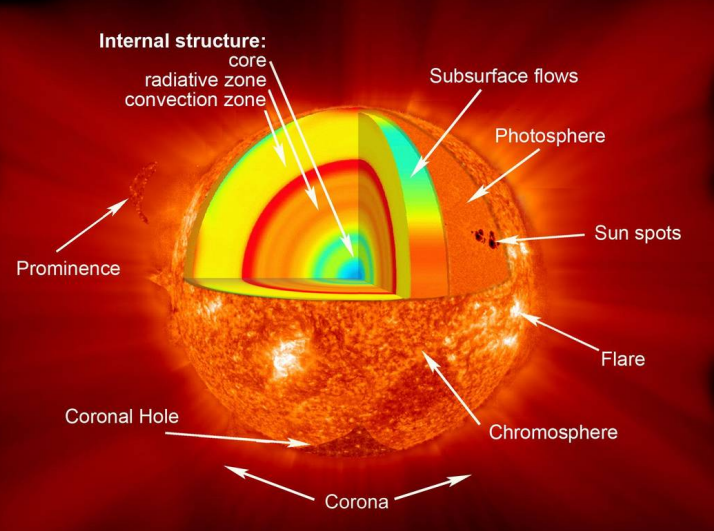
Key Facts about the Sun
| Aspect | Details |
|---|---|
| Type | Star (central body of Solar System) |
| Age | ~5 billion years |
| Composition | Hydrogen and Helium |
| Diameter | 1,392,000 km |
| Core Temperature | ~15 million °C |
| Surface Temperature | ~5,500 °C |
Layers of the Sun
| Layer | Description |
|---|---|
| Core | Site of nuclear fusion, hottest region. |
| Radiative Zone | Energy transferred by photons. |
| Convection Zone | Energy rises via convection currents. |
| Photosphere | Visible surface, radiates light. |
| Chromosphere | Layer above photosphere (~2100 km). |
| Transition Region | Between chromosphere and corona; temperature rises sharply. |
| Corona | Outermost layer, visible during solar eclipse. |
Mains Key Points
Prelims Strategy Tips
Associated Solar Concepts
Several dynamic phenomena are associated with the Sun such as sunspots, solar wind, coronal mass ejections (CME), and solar cycles. These impact Earth’s magnetosphere and atmosphere, producing effects like auroras and STEVE.
Several dynamic phenomena are associated with the Sun such as sunspots, solar wind, coronal mass ejections (CME), and solar cycles. These impact Earth’s magnetosphere and atmosphere, producing effects like auroras and STEVE.
Associated Solar Phenomena
| Phenomenon | Description | Impact/Effect |
|---|---|---|
| Sun Spots | Dark, cooler regions on Sun's surface. | Indicator of solar activity. |
| Solar Wind | Plasma stream from corona. | Affects Earth's magnetosphere. |
| CME | Ejection of plasma & magnetic field. | Causes geomagnetic storms on Earth. |
| Solar Cycle | 11-year magnetic field cycle. | Poles flip, affecting solar activity. |
| Auroras | Charged particles interact with atmosphere. | Aurora Borealis & Australis lights. |
| STEVE | Aurora-like magenta streaks. | Caused by heated glowing gas. |
Mains Key Points
Prelims Strategy Tips
Planets
Planets are celestial objects that orbit stars in elliptical paths. Apart from classical planets, there are dwarf planets, exoplanets, and protoplanets. Pluto, once considered the ninth planet, is now categorized as the largest dwarf planet with unique features.
Planets are celestial objects that orbit stars in elliptical paths. Apart from classical planets, there are dwarf planets, exoplanets, and protoplanets. Pluto, once considered the ninth planet, is now categorized as the largest dwarf planet with unique features.
Types of Planets
| Type | Description | Example |
|---|---|---|
| Planet | Object orbiting a star in elliptical path. | Earth, Jupiter |
| Dwarf Planet | Small, indistinct orbit. | Pluto, Ceres |
| Exoplanet | Planet outside Solar System. | Kepler-22b |
| Protoplanet | Developing celestial body orbiting a star. | AB Aurigae b |
Pluto – Key Facts
| Aspect | Details |
|---|---|
| Type | Dwarf Planet |
| Location | Kuiper Belt |
| Rotation Period | 6 Earth days |
| Revolution Period | 248 Earth years |
| Moons | 5 (largest = Charon) |
| Rings | None |
Mains Key Points
Prelims Strategy Tips
Classification of Planets
Planets are classified into Inner (Terrestrial) and Outer (Jovian) planets. Inner planets (Mercury, Venus, Earth, Mars) are rocky, dense, with solid surfaces and iron cores. Outer planets (Jupiter, Saturn, Uranus, Neptune) are gas giants, less dense, and lack solid surfaces.
Planets are classified into Inner (Terrestrial) and Outer (Jovian) planets. Inner planets (Mercury, Venus, Earth, Mars) are rocky, dense, with solid surfaces and iron cores. Outer planets (Jupiter, Saturn, Uranus, Neptune) are gas giants, less dense, and lack solid surfaces.
Comparison of Inner and Outer Planets
| Aspect | Inner Planets (Terrestrial) | Outer Planets (Jovian) |
|---|---|---|
| Examples | Mercury, Venus, Earth, Mars | Jupiter, Saturn, Uranus, Neptune |
| Distance from Sun | Closer to Sun | Farther from Sun |
| Surface | Solid, rocky surface | No solid surface |
| Density | High (dense) | Low (less dense) |
| Core | Iron core present | Mostly gases, no solid core |
| Other Name | Terrestrial Planets | Gas Giants |
Mains Key Points
Prelims Strategy Tips
Planets and Important Facts
Each planet in the Solar System has unique features related to rotation, revolution, moons, rings, and physical characteristics. While Mercury is the fastest planet, Venus is the hottest, Earth supports life, Mars appears red, and Jupiter is the largest. Saturn has magnificent rings, Uranus is called an Ice Giant, and Neptune is Uranus’s twin.
Each planet in the Solar System has unique features related to rotation, revolution, moons, rings, and physical characteristics. While Mercury is the fastest planet, Venus is the hottest, Earth supports life, Mars appears red, and Jupiter is the largest. Saturn has magnificent rings, Uranus is called an Ice Giant, and Neptune is Uranus’s twin.
Planets – Key Facts
| Planet | Order from Sun | Rotation Period | Revolution Period | Moons | Rings | Other Facts |
|---|---|---|---|---|---|---|
| Mercury | 1 | 59 Earth days | 88 Earth days | 0 | 0 | Fastest planet, travels at 47 km/s |
| Venus | 2 | 243 Earth days | 225 Earth days | 0 | 0 | Hottest planet; rotates backward (clockwise); Sun rises in West and sets in East |
| Earth | 3 | 24 hours | 365 days | 1 | 0 | Oblate spheroid; 5th largest; only planet with liquid water; densest planet |
| Mars | 4 | 24+ hours | 687 Earth days | 2 (Phobos, Deimos) | 0 | Reddish appearance due to iron minerals |
| Jupiter | 5 | 10 hours | 12 Earth years | 80 (largest = Ganymede) | Yes | Largest planet; gas giant; no solid surface |
| Saturn | 6 | 10.7 hours | 29 Earth years | 83 (largest = Titan) | Yes (7) | Gas giant; iconic ring system |
| Uranus | 7 | 17 hours | 84 Earth years | 27 | Yes (13) | Ice Giant; hot dense fluid of water, methane, ammonia |
| Neptune | 8 | 16 hours | 165 Earth years | 14 | Yes (9) | Uranus’s twin in size, structure, composition |
Mains Key Points
Prelims Strategy Tips
Kuiper Belt, Oort Cloud, Asteroids, and Comets
Beyond Neptune lies the Kuiper Belt, a region of icy remnants from Solar System formation. Further out is the Oort Cloud, a spherical shell of comets. Asteroids are rocky, smaller bodies with elliptical orbits, while comets are icy objects with eccentric orbits that develop characteristic tails when near the Sun.
Beyond Neptune lies the Kuiper Belt, a region of icy remnants from Solar System formation. Further out is the Oort Cloud, a spherical shell of comets. Asteroids are rocky, smaller bodies with elliptical orbits, while comets are icy objects with eccentric orbits that develop characteristic tails when near the Sun.
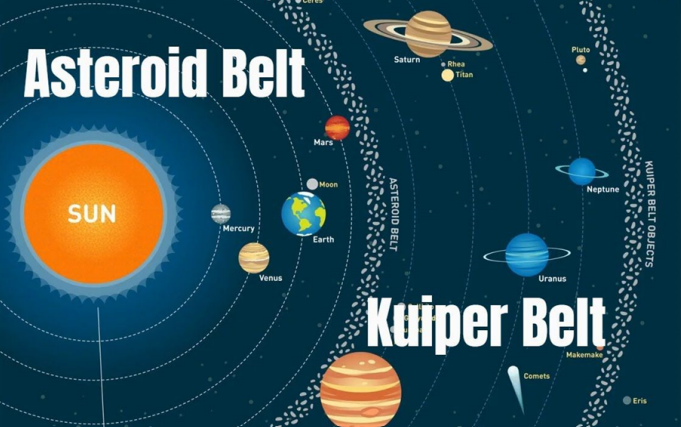
Comparison of Asteroids and Comets
| Feature | Asteroids | Comets |
|---|---|---|
| Composition | Rocky | Ice, dust, frozen gases |
| Orbit | Elliptical, less eccentric | Highly eccentric |
| Size | Smaller | Larger |
| Tail | None | Develops a tail near the Sun |
| Examples | Vesta, Eros, Bennu | Halley’s Comet, Bernardinelli-Bernstein |
Mains Key Points
Prelims Strategy Tips
Meteors, Meteoroids, and Meteorites
Meteoroids are small space rocks. When they enter Earth’s atmosphere, they become meteors (shooting stars). If they survive and reach Earth’s surface, they are called meteorites. Meteor showers occur when Earth passes through a stream of meteoroids. These phenomena provide insights into the Solar System’s composition and evolution.
Meteoroids are small space rocks. When they enter Earth’s atmosphere, they become meteors (shooting stars). If they survive and reach Earth’s surface, they are called meteorites. Meteor showers occur when Earth passes through a stream of meteoroids. These phenomena provide insights into the Solar System’s composition and evolution.
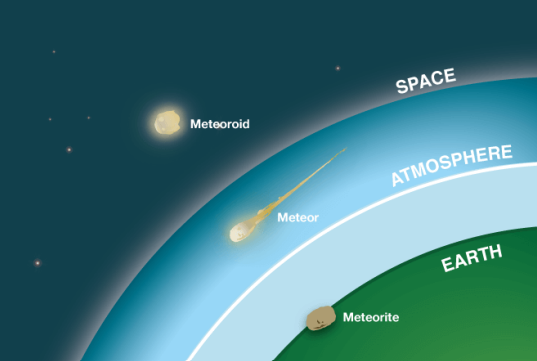
Difference between Meteoroids, Meteors, and Meteorites
| Term | Definition | Special Notes |
|---|---|---|
| Meteoroid | Space rock (dust grain to small asteroid) floating in space. | Originates from asteroids/comets. |
| Meteor | Meteoroid entering atmosphere; burns due to friction, appears as shooting star. | Large ones are called fireballs or bolides. |
| Meteorite | Meteor that survives atmosphere and hits Earth’s surface. | Classified as stony, iron, or stony-iron. |
Mains Key Points
Prelims Strategy Tips
Geological Time Scale
The Geological Time Scale (GTS) is the calendar of Earth's history, dividing it into eons, eras, periods, epochs, and ages. It helps trace the evolution of life, flora, and fauna across billions of years.
The Geological Time Scale (GTS) is the calendar of Earth's history, dividing it into eons, eras, periods, epochs, and ages. It helps trace the evolution of life, flora, and fauna across billions of years.
Geological Time Scale – Summary
| Era | Period/Epoch | Major Life Forms | Major Flora |
|---|---|---|---|
| Cenozoic | Quaternary (Holocene, Pleistocene) | Mammals, Humans | Angiosperms |
| Cenozoic | Tertiary (Pliocene, Miocene, etc.) | Mammals, Birds, Early Humans | Dicotyledons |
| Mesozoic | Cretaceous, Jurassic, Triassic | Dinosaurs, Reptiles, First Mammals | Cycads, Conifers, Angiosperms |
| Paleozoic | Permian to Cambrian | Fishes, Amphibians, Reptiles, Invertebrates | Ferns, Seed Ferns, Algae |
| Precambrian | Upper, Middle, Lower | Prokaryotes → Eukaryotes → Multicellular | Primitive algae, plankton |
Mains Key Points
Prelims Strategy Tips
Geographical Grid, Latitude and Longitude
The geographical grid is a network of imaginary lines—latitude and longitude—used to determine exact locations on Earth. Latitudes measure north-south distance from the Equator, while longitudes measure east-west distance from the Prime Meridian.
The geographical grid is a network of imaginary lines—latitude and longitude—used to determine exact locations on Earth. Latitudes measure north-south distance from the Equator, while longitudes measure east-west distance from the Prime Meridian.
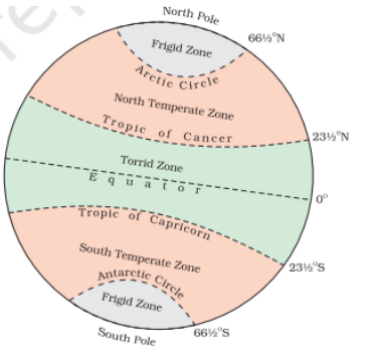
Important Latitudes
| Latitude | Position/Value | Significance |
|---|---|---|
| Equator | 0° | Divides Earth into Northern & Southern Hemispheres; Great Circle |
| Tropic of Cancer | 23.5° N | Northernmost latitude with overhead Sun (June Solstice) |
| Tropic of Capricorn | 23.5° S | Southernmost latitude with overhead Sun (December Solstice) |
| Arctic Circle | 66.5° N | Defines polar region in Northern Hemisphere |
| Antarctic Circle | 66.5° S | Defines polar region in Southern Hemisphere |
| North Pole | 90° N | Extreme northern latitude |
| South Pole | 90° S | Extreme southern latitude |
Mains Key Points
Prelims Strategy Tips
Latitude, Longitude and Global Reference Lines
Latitudes and longitudes form the geographical grid, the basis of navigation and location mapping. Important reference lines include the Equator, Tropic of Cancer, Tropic of Capricorn, Arctic and Antarctic Circles, Prime Meridian, and International Date Line. These define hemispheres, time zones, and climatic regions of the Earth.
Latitudes and longitudes form the geographical grid, the basis of navigation and location mapping. Important reference lines include the Equator, Tropic of Cancer, Tropic of Capricorn, Arctic and Antarctic Circles, Prime Meridian, and International Date Line. These define hemispheres, time zones, and climatic regions of the Earth.
Special Latitudes and Longitudes
| Line | Position | Key Facts |
|---|---|---|
| Equator | 0° latitude | Longest latitude, Great Circle, divides Earth into hemispheres |
| Tropic of Cancer | 23.5° N | Overhead Sun at June Solstice; passes through India |
| Tropic of Capricorn | 23.5° S | Overhead Sun at December Solstice; Southern Hemisphere tropics |
| Arctic Circle | 66.5° N | Boundary of polar day/night phenomena |
| Antarctic Circle | 66.5° S | Marks Southern polar region |
| Prime Meridian | 0° longitude | Basis of GMT/UTC; divides Eastern and Western Hemispheres |
| International Date Line | ~180° longitude | Date changes; zig-zags across Pacific |
Mains Key Points
Prelims Strategy Tips
Different Motions of the Earth
The Earth has four key motions: rotation, revolution, axial tilt, and polar motion. Rotation defines day-night and Coriolis Effect, revolution defines year and seasons, tilt defines solstices/equinoxes, and polar motion reflects Earth’s dynamic axis shifts. Human activities (glacier melting, groundwater extraction) are now altering Earth’s axis.
The Earth has four key motions: rotation, revolution, axial tilt, and polar motion. Rotation defines day-night and Coriolis Effect, revolution defines year and seasons, tilt defines solstices/equinoxes, and polar motion reflects Earth’s dynamic axis shifts. Human activities (glacier melting, groundwater extraction) are now altering Earth’s axis.
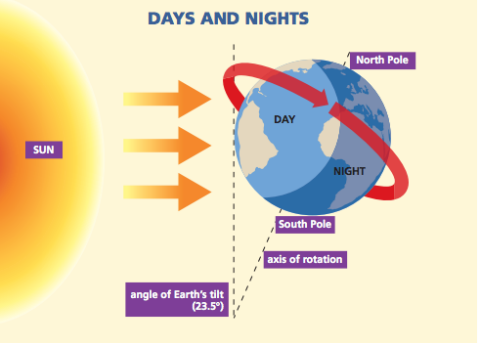
Earth’s Motions and Effects
| Motion | Duration | Key Effects |
|---|---|---|
| Rotation | 23h 56m 4s (sidereal) | Day-night cycle, Coriolis Effect, winds, currents, tides. |
| Revolution | 365d 6h 9m | Seasons, solstices, equinoxes, Aphelion (July 4), Perihelion (Jan 3). |
| Axis Tilt | 23.5° | Seasonal variation, climatic zones, length of day-night. |
| Polar Motion | Variable | Axis drift due to ice melt, groundwater depletion, atmospheric changes. |
Mains Key Points
Prelims Strategy Tips
Seasons
Earth experiences four major seasons—Summer, Winter, Spring, and Autumn—caused by its revolution around the Sun and axial tilt (23.5°). While one hemisphere has summer, the other has winter. Solstices and equinoxes mark the transition points. Polar regions experience continuous day or night for six months. Seasonal cycles are also linked with agriculture, monsoon, and cultural traditions.
Earth experiences four major seasons—Summer, Winter, Spring, and Autumn—caused by its revolution around the Sun and axial tilt (23.5°). While one hemisphere has summer, the other has winter. Solstices and equinoxes mark the transition points. Polar regions experience continuous day or night for six months. Seasonal cycles are also linked with agriculture, monsoon, and cultural traditions.
Seasonal Cycle in Hemispheres
| Months | Northern Hemisphere | Southern Hemisphere | Special Phenomena |
|---|---|---|---|
| June - August | Summer; long days; Midnight Sun in Arctic | Winter; long nights; Polar Night in Antarctic | Sun overhead Tropic of Cancer (21 June) |
| December - February | Winter; long nights | Summer; long days | Sun overhead Tropic of Capricorn (22 Dec) |
| March - May | Spring | Autumn | Equinox: Sun overhead Equator (21 March) |
| September - November | Autumn | Spring | Equinox: Sun overhead Equator (23 September) |
Mains Key Points
Prelims Strategy Tips
Solstices and Equinoxes
Solstices and equinoxes mark the key turning points in Earth’s revolution. Solstices (21 June and 22 December) are the longest and shortest days of the year, while equinoxes (21 March and 23 September) have equal day and night worldwide.
Solstices and equinoxes mark the key turning points in Earth’s revolution. Solstices (21 June and 22 December) are the longest and shortest days of the year, while equinoxes (21 March and 23 September) have equal day and night worldwide.
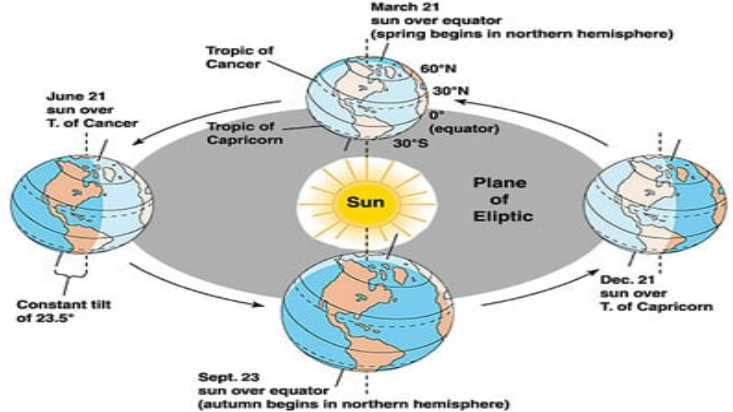
Comparison of Solstices and Equinoxes
| Event | Date | Sun Position | Northern Hemisphere | Southern Hemisphere |
|---|---|---|---|---|
| Summer Solstice | 21 June | Over Tropic of Cancer | Longest day, shortest night | Shortest day, longest night |
| Winter Solstice | 22 December | Over Tropic of Capricorn | Shortest day, longest night | Longest day, shortest night |
| Spring Equinox | 21 March | Over Equator | Equal day & night; Spring begins | Equal day & night; Autumn begins |
| Autumn Equinox | 23 September | Over Equator | Equal day & night; Autumn begins | Equal day & night; Spring begins |
Mains Key Points
Prelims Strategy Tips
Chapter Complete!
Ready to move to the next chapter?
